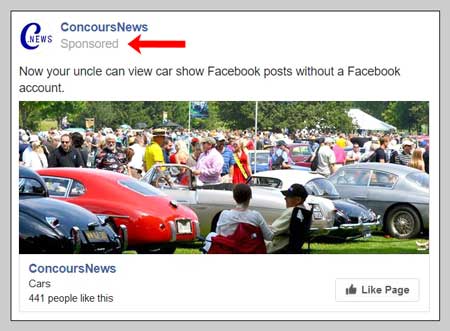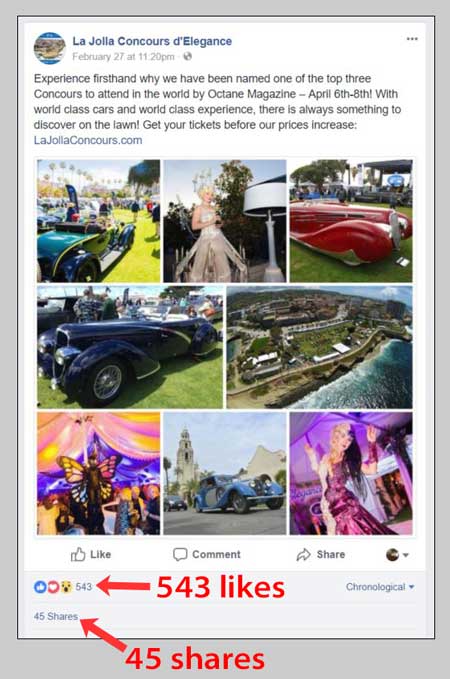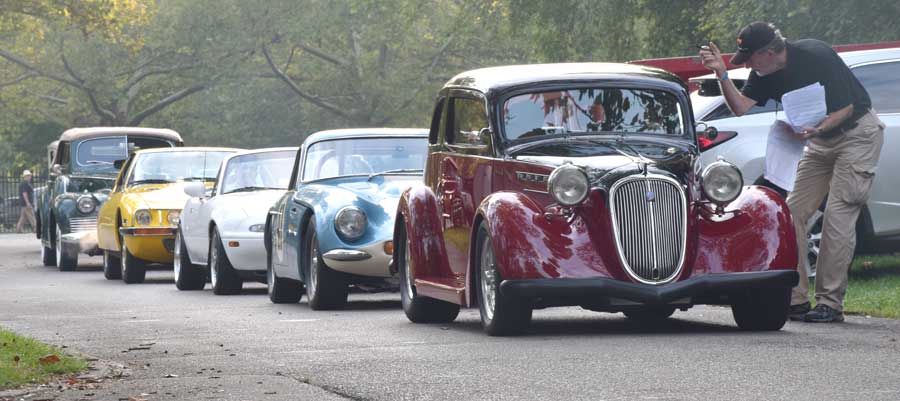There’s concern among car lovers that early morning queues of anxious enthusiasts awaiting entry to classic car shows are gradually lessening in quantity, if not in fervor, due to the aging demographics of the hobby. While only some factions of the hobby are indeed experiencing negative growth, it would be advantageous if all performed some “preventive maintenance” using a tool already in the toolbox of most car show organizers: social media.
Segments of the collector car industry – notably forward-thinking insurance companies, auctioneers, publications and suppliers – have embraced social media to convey their message to an exponentially larger audience than ever before. At the less commercial end of the spectrum, however, are a number of car show organizers and volunteers who aren’t totally hip to Facebook and Twitter, the giants of social media platforms.
The spreadsheet below contains data about the Facebook usage of 28 premiere concours d’elegance events in the US and Canada. These events are significant in that they represent the highest level of critically judged, multi-marque shows. Because they are either charitable non-profit entities themselves or are closely associated with one, the success of each show impacts the well-being of the surrounding communities.
You are trying to load a table of an unknown type. Probably you did not activate the addon which is required to use this table type.
This short list of concours d’elegance productions has potential to significantly shape the future of the collector car industry. The vehicle displays and related activities – including auctions, seminars, tours, galas and more – are covered by national, and sometimes international, automotive journalists. Car exhibitors and attendees represent a who’s who of the automotive industry, with the capabilities to set trends that positively shape the future of the collector vehicle hobby (which includes cars, trucks, motorcycles and other means of transportation).
It is important to note that three years ago, this list would have included 11 additional* concours events that have since discontinued operation due to availability of venues, sponsors and presumably economic viability. This is why now, more than ever, car shows need to go the extra mile not only in marketing their own events, but to take proactive measures to ensure widespread continued interest in collector vehicles.
This spreadsheet shows the number of Facebook likes as of March 13, 2018. It is interactive, making it possible to click each column head to sort content alphabetically or numerically. Clicking on the event name will take you to its Facebook feed at www.concours.NEWS. (The list will be updated periodically in future blog posts.)
For those unfamiliar with Facebook: a post (which is on a page) can be viewed by thousands of visitors who seek out or are directed to that page, which has a specific web address. A page can have an unlimited number of posts. A “like” occurs when a reader makes a deliberate selection acknowledging that he or she enjoyed the post (which is a “post like”) or the entire page, as a whole (which is a “page like”). Instead of calling someone who likes a page a “liker,” they are called a “follower.” Pages can actually like other pages, meaning it’s a great way for like-minded pages and organizations to connect and interact.
What the numbers reveal
For the following analysis, the Pebble Beach Concours d’Elegance, which is in a class unto itself with 49,000+ Facebook likes, is not included. Nor is the Concours d’Elegance at Copshaholm in South Bend, Indiana, which is conducting its first show this summer as a “replacement” on the calendar for the nearby recently discontinued (and popular) Lake Bluff Concours of Southwest Michigan.
Some observations:
- The three concours shown below Pebble Beach — Hilton Head Island Concours, Greenwich Concours and Amelia Island Concours — combine for 50,517 likes.
- That’s 3,819 more than the remaining 23 concours combined, which average about 2,000 likes each.
- Within that group, there are only four shows with more than 3,000 likes: LaJolla Concours (4,981), Concours d’Elegance of America at St. John’s (4,457), Cincinnati Concours (3,560) and the Elegance at Hershey (3,524).
- The concours with the most likes are the better known ones that attract car entries from all across the country, whereas those toward the bottom tend to be more regional in their draw.
- A large number of page likes will place an event toward the top of a list and maybe impress a potential sponsor who doesn’t understand the nuances of Facebook, but if nobody ever sees your posts, you’ve failed at social media.
The purpose of this analysis is not to pass judgment on any one event’s popularity, ability to raise money for charities or marketing strategy. Rather it is an opportunity (and a nudge) to these concours and every other car show to review their respective marketing plans and see what may or may not be working for the others from the standpoint of social media.
How car shows can increase page likes
In years past, car shows saw their page likes increase because Facebook matched post content with user’s interests and a connection was made. Not so anymore. The good news is that Facebook is extremely proficient at helping pages target customers… for a fee.
The cost effective way to get thousands of additional followers is with a Facebook ad campaign. It sounds fancy, but anyone with a little marketing or advertising know-how can make it happen.
Here’s a Facebook ad that’s designed to get likes for a page. It has a “Like Page” button and “Sponsored” notation and appears in someone’s personal feed or in the right sidebar along with other messages. Facebook makes it simple to define an audience using criteria such as geographic location, social interests, what kind of cars they like and other demographics.

The cost-per-like can be as low as a few cents to 50 cents or more, depending on Facebook algorithms and how compelling the content. Money spent on targeted ads and boosted posts WILL have a direct impact on the success of a car show. It’s remarkable how far a couple hundred dollars on a Facebook Ad Campaign will go toward increasing sales of tickets costing $20 to $100 or more. And it doesn’t take a marketing professional to attain success.
Page likes are worthless without post likes
Regardless of how many likes a page may have, Facebook will not effectively distribute posts to followers without financial incentive.
Need proof? Click on a few of the concours show links in the table to view an event’s Facebook feed. Look for the white rectangular box with icons and numbers at the bottom of each post. There’s a thumb’s up or heart icon showing the number of likes and an arrow icon for number of shares. On the great majority of pages, you will rarely see a post with more than a couple dozen likes and maybe a couple of shares. That’s because only a few concours events utilize Facebook ads.

Boosting generates post likes
Check out the performance numbers on this recent Facebook post made by the LaJolla Concours d’Elegance in San Diego. Wow! A message liked by 543 people and shared 45 times… results like that are a rarity with any of the shows, except for LaJolla, where they know how to BOOST.

To reach a well-defined audience — i.e. those who have already liked an entire page — social media managers need to click the blue “Boost Post” button appearing on their special administrator screen after making a post. That’s the key to releasing all those carefully crafted posts to the world. Next, the page manager can select a custom audience similar to the campaign for page likes discussed earlier, or better yet, click the option that delivers the message to “People who like your Page and their friends.” A $5 expenditure can parlay into well over 100 post likes.
Next, the page manager can select a custom audience similar to the campaign for page likes discussed earlier, or better yet, click the option that delivers the message to “People who like your Page and their friends.” A $5 expenditure can parlay into well over 100 post likes.
Post likes and comments provide excellent feedback to event staff and selection committees that helps them in producing successful shows and related activities. A share is the ultimate like. When a post receives a ton of shares, the event producers know they’re on the right track!
The Facebook promotion summary will show how many people in the target audience were reached and how many post engagements, such as likes or comments, took place. The analytics contain a wealth of information that’s helpful to prospective advertisers and sponsors.
The bottom line
Rather than treat social media as a necessary evil, perhaps it’s time for some events to recognize Facebook and other platforms as economical tools for building brand loyalty and ensuring a healthy future. The collector car realm will be better for it, patrons will love seeing what’s been diligently posted on your page, sponsorships will increase, charities will greatly appreciate additional revenue and awareness, which in turn, will benefit the well-being of the community.
The eleven established concours d’elegance events that were discontinued over the last three years are: Arizona Concours, Lake Bluff Concours d’Elegance of Southwest Michigan, Pinehurst Concours, Greystone Concours, Art of the Car, Monmouth County Concours, Edison Concours, Pacific Northwest Concours, San Luis Obispo Concours, Santa Fe Concours and Winter Park Concours.These events meet the standards for inclusion in the above list, but are not shown:
— Geneva Concours d’Elegance: has Facebook group page rather than business page,
— Hemmings Concours: no Facebook page specific to the concours,
— Hillsborough Concours: Facebook page not functional.
John Olman is developer and editor of ConcoursDates.com and concours.NEWS. He may be contacted HERE.

